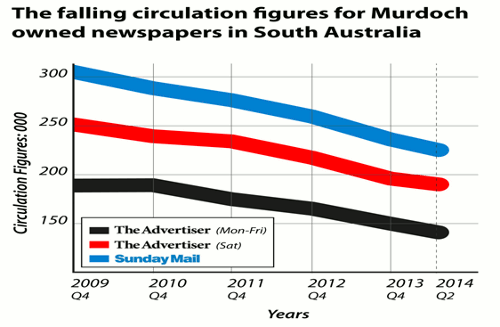South Australian's only daily and weekend newspapers are in dire straits as the downward trend in circulation and advertising revenue cannot be stopped.
Like most large metropolitan newspapers, The Advertiser has been squeezed by high news gathering costs, decreasing ad revenue (the classifieds have fled online) and a loss of consumers.
According to the Audit Bureau of Circulation (ABC), since 2009 the weekday Advertiser has lost 39,818 in sales, the Saturday Advertiser is down 59,978 and the Sunday Mail has plummeted a whopping 74,971. Each masthead is currently dropping at about 9 per cent per annum. ABC trend data is listed for the three mastheads below.
Advertisement

News Corporation spins these numbers by combining monthly 'readership' figures with unique page clicks on its online newspapers. Don't be fooled. If a man picks up a copy of The Advertiser at the dentist, he is counted as a 'reader'. So are the dentist, the receptionist and all the patients that day.
The Advertiser gets many more 'readers' online than the print edition because most visitors come to consume free information such as weather, dating opportunities and the constant stream of 'clickbait' celebrity, lifestyle and 'man bites dog' stories. Few are there for the reporting.
A recently leaked News Corporation report to Crikey, showed how Murdoch's Australian newspapers were travelling in 2012-13. The Advertiser and Sunday Mail budgeted income for the year 2013-12 was $30 million. They scraped in at $22 million – almost half that of the previous year ($42 million).
The Advertiser and Sunday Mail sacked 195 staff in 2012-13 and another 23 got the chop from the Messenger. This typifies the 'creative destruction' running through the global newspaper industry. The Advertiser, like the Titanic, is going down bow first.
The speed at which Google has vanquished Gutenberg is astounding. Over the last five years, 24 large US newspapers have closed and almost as many have cut back to publishing two or three editions a week.Newspapers are expensive to produce. They require highly skilled staff, large complex printers, kilometres of paper and a distribution network.
Advertisement
Surely SA's online subscribers will come to The Advertiser's rescue?
News Corporation won't release the online subscription figures for The Advertiser. Even so, it's pay walls won't make up for the shortfall in newspaper sales and ad revenue. Currently, The Advertiser charges $6.00 a week in subscriptions for all three papers. This is not nearly enough.
As for online advertising, as Eric Beecher said in an essay in The Monthly (July) last year, "It (the Internet) is the first mass medium with almost no barriers to entry and practically unlimited content carrying capacity. These two factors have converged to create millions of websites and blogs, billions of webpages resulting in the collapse of online advertising rates for all but highly specialized or unique websites."
Digital advertising is expected to account for just one third of advertising revenue for Australian newspaper publishers by 2018.No stand alone news website in the world can support even a fraction of the journalistic resources of a major metropolitan newspaper. There is no crossing over from the old newspaper platform and replicating it in the online world.
The 'Tiser' was a primary node of influence connecting Adelaide's businessmen and women. It appeared - superficially at least - as liberal, humanist and even handed, but its normative values supported a deeply orthodox political mindset.
It patrolled the status quo like a Rottweiler, making it completely unfit to discuss how radical changes such as globalization, deregulation, the rise of Asian manufacturing and online trading, would effect South Australians and especially local business.
It slumped from a newspaper of record under the great editorships of Des Colquhoun and Don Riddell, to become mired in parochialism after the News Ltd take over in 1987. To be fair, no alternative political ideologies or business philosophies were savaged. They simply weren't reported.
The journalists on the whole were very good – some were excellent. It was management who treated the public like morons, and in the hunt for the lowest common denominator, drove the newspaper so low in the market, one needed to decompress after reading it.
No matter what I think, the fact is that The Advertiser's days of setting the news agenda in SA are almost over. But before the champagne corks fly, for all of the 'Tiser's' faults, ask, who will guard the public against the incompetent politicians we elected? Who will expose those who do deals in the dead of night?
South Australia is entering the most serious economic downturn since Federation. The threat is that without accurate and timely local news, we will have to rely on what our mediocre MP's say and do. The opportunities though are boundless. From the ashes will rise new, nimble and niche online publishers, who will write without fear or favour. There are signs of this already with the rise of InDaily and In-Business.
For more than two centuries, newspapers have been an indispensable source of public information. People still want the news. Let me amend that. People need the news. It's as vital to democracy as sunlight is to crops.